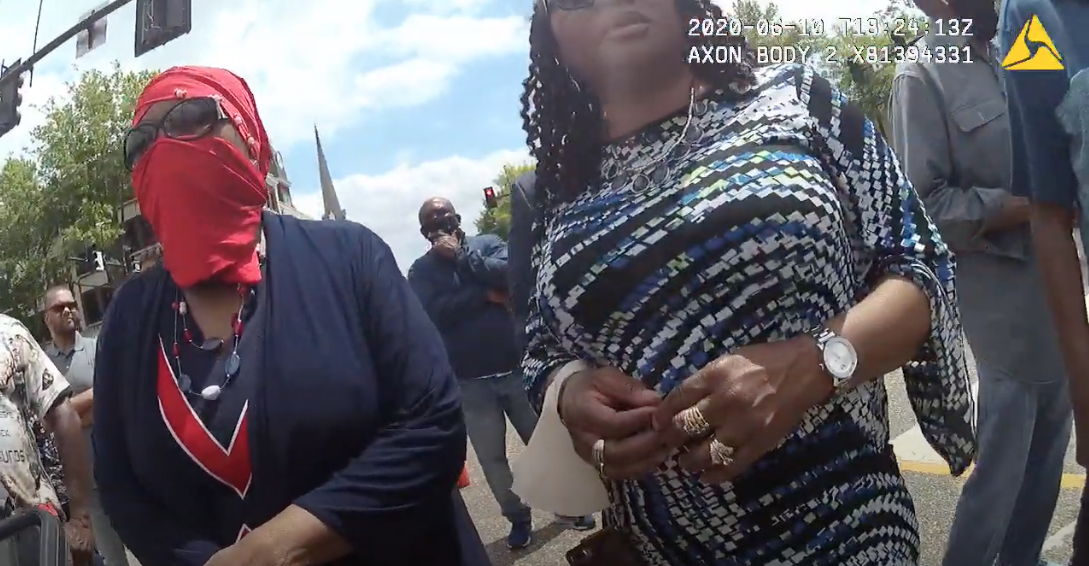The charge by Portsmouth, Virginia, police that State Senator Louise Lucas participated in a conspiracy to take down a Confederate monument this past June is itself a monument of weirdness. The police also charged the city’s public defender, two members of her office, a member of the school board, the president and vice-president of the Portsmouth NAACP, among others. They didn’t pursue charges through the Commonwealth Attorney’s office in the Tidewater city and even named the city’s progressive prosecutor, Stephanie Morales, as a potential witness.
But before we get into the events that led up to the felony charges, announced by Portsmouth Police Chief Angela Greene the day before Lucas, a Democrat and the Senate’s president pro tempore, was due in Richmond for a General Assembly special session, a detour into the law under which Lucas et al. were charged is in order. The Portsmouth police say Lucas committed two felonies: injury to a monument, and a conspiracy to commit a felony.
Wait, “injury to a monument” is a felony in Virginia? Well. Section 18.2-137 of the Virginia Code prohibits damage to private property, though it allows for class 3 misdemeanor charges for damage to “any monument or memorial for war veterans” that does not belong to the person charged, as well as “any monument erected to mark the site of any engagement fought during the Civil War” or “any memorial to designate the boundaries of any city, town, tract of land, or any tree marked for that purpose.”
There haven’t been any appeals courts cases that involved this statute and monuments, says Darryl Brown, a professor at the University of Virginia School of Law, which leads him to “assume that this has rarely if ever been used to prosecute people who damage monuments.” The statute does, however, prohibit damage to a war veterans’ memorial, Brown says, “so it would not be a stretch to charge people with this offense if they painted or damaged statue that was a ‘war veterans monument.'” Lucas, though, hasn’t been charged with doing that.
So let’s dig in a bit to the monument in question, and the events of June 10.
The Confederate Monument in Portsmouth, like other prominent monuments in Tidewater, was completed in 1893 and is located on a site of historical importance for the region’s slave trade—it replaced a whipping post where enslaved people were tortured publicly. Some modern Confederate sympathizers say these locations are mere coincidences, but even if so they’re coincidences that dovetailed tightly with the post-Civil War South’s attempts to enshrine white supremacy into every aspect of public life.
Like many such monuments in the South, Portsmouth’s has grown increasingly unpopular, especially after the 2017 Unite the Right rally in Charlottesville; that same year, a petition to replace it with a statue of Portsmouth native Missy “Misdemeanor” Elliott received international media attention. Until this July, Virginia localities had very limited power to remove Confederate monuments.
As activists gathered at Portsmouth’s Confederate Monument this past June 10, a fence appeared around it with signs that warned against “trespassing.” That evening, according to Greene’s own body-worn camera footage, the police chief approached a group of perhaps two dozen demonstrators nearby. Lucas was there alongside Vice-Mayor Lisa Lucas-Burke, arguing that the police couldn’t arrest anyone for trespassing on what she said was city property. As they argued, the demonstrators began to climb over the fences and spray-painted the monument. “It is city owned property. They pay their taxes. They’ve got a right to get on their own property,” Lucas told Greene.
Hours later, long after Lucas says she departed, protesters beheaded and toppled four statues of Confederates that surrounded the 35-foot obelisk. One man was seriously injured when one of the statues fell.
The charges against Lucas and others do not involve the injury to a person, however, only the injury to the monument. The Commonwealth’s Attorney’s office says in a statement the police’s decision to name Morales could create a conflict of interest and also expressed bafflement that she was named at all, since, the office says, Morales was nowhere near the monument on June 10. Morales’ office says the police haven’t shared any of the results of their investigation, either, which suggests strongly that the police department hopes to sideline her altogether and have a special prosecutor pursue the charges. The police secured its warrants through a magistrate instead.
None of the media accounts of what happened June 10 lend themselves to charges of a conspiracy, says U.Va.’s Brown: “I’d say charging the senator with conspiracy to violate this statute is a very aggressive law enforcement decision, and one unlikely to result in a conviction.” Lucas’s statements were to police, he notes, not to protesters.
Lucas has a court date set for September after she was served with a warrant Tuesday evening. She is currently taking part in the General Assembly’s special session, during which its Democratic majority hopes to enact police reform.



















